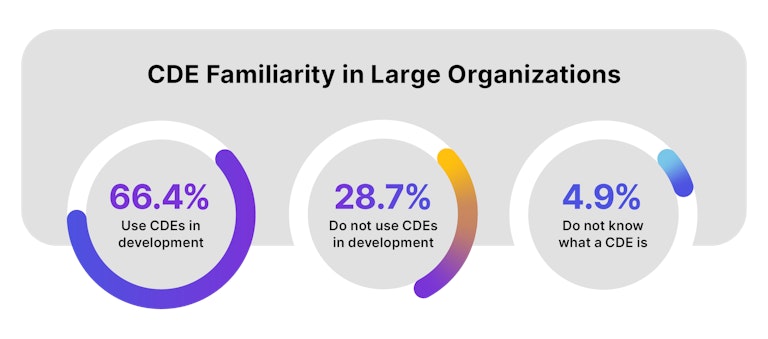Cloud-Based Development Platforms: The New Frontier of Coding Efficiency
 Dmitry Broshkov
Dmitry Broshkov
In recent years, there has been a noticeable shift in the way software developers approach their craft. Traditional local development environments, once the norm, are being replaced or supplemented by Cloud Development Environments (CDEs).

This evolution is not just a matter of preference; it’s driven by a confluence of factors that are reshaping how we think about programming productivity. This article delves into the reasons behind the accelerating adoption of CDEs, their growing prevalence across industries, and the immense potential they hold for the future of software development.
What is Driving This Rapid Advancement?
The rise of Cloud Development Environments is a response to several overarching trends in both software development and business operations. A few decades ago, most developers would have sworn by their local environments, meticulously tailored to their specific workflows. However, this practice comes with its own set of drawbacks. Configuring and maintaining local development environments can be a time-consuming task, prone to errors and inconsistencies across teams. Additionally, ensuring that every developer has the same environment, libraries, and tools is a challenge—especially when working with globally distributed teams.
Enter Cloud Development Environments. A CDE is a development environment that exists entirely in the cloud. Instead of working on code locally, developers can log into a browser-based interface that hosts their environment. This provides a more consistent and scalable development experience while reducing the friction that often comes with traditional setups. But what exactly is behind this rapid shift?
One of the main drivers is speed. In today’s fast-paced technological landscape, businesses demand quicker releases, more responsive updates, and shorter development cycles. Traditional environments often slow things down due to long setup times, machine-specific quirks, or infrastructure issues. With CDEs, developers can spin up a fresh environment in seconds, making it possible to write and test code without delays. This naturally leads to faster onboarding for new developers, as they can dive straight into coding without spending hours (or days) configuring their machines.
Moreover, collaboration has become a critical aspect of modern software development, especially with the rise of remote work. Developers working on the same project often need to share their environments, review code, and debug issues together. CDEs allow for real-time collaboration, much like how Google Docs enables multiple users to work on the same document simultaneously. This capability eliminates the "it works on my machine" problem, ensuring that all team members are working from the same codebase and with the same configurations.
Security is another key consideration. With code and data stored in the cloud, sensitive information is no longer vulnerable to loss or theft from local machines. Cloud providers typically offer better security measures than what many organisations can implement in-house, such as advanced encryption, intrusion detection, and automated backups.
The push towards containerisation and microservices architecture also plays a significant role. Developers are increasingly working in environments where applications consist of dozens or even hundreds of microservices, each with its own dependencies. Managing this complexity locally can be overwhelming. By contrast, CDEs, often built on top of containers such as Docker or Kubernetes, provide isolated, pre-configured environments that can be easily replicated and scaled across different teams or projects.
CDE Awareness is Broadly Recognised
Cloud Development Environments are no longer a niche concept known only to a few. A recent survey showed that 95% of software developers are now familiar with CDEs. This widespread awareness can be attributed to the fact that major players like GitHub (with GitHub Codespaces), AWS Cloud9, and Google Cloud Shell have popularised these platforms, making them accessible and user-friendly.
The appeal is clear: the majority of developers have come to understand the significant benefits of moving away from local development environments. According to the survey, 72% of developers who have transitioned to CDEs cite reduced setup time as their primary reason for switching. Instead of spending valuable hours configuring tools and dependencies, they can focus on the task at hand—coding.
Furthermore, many of these CDE platforms offer customisation options, enabling developers to tailor their cloud environment to mirror their local setups. This means that while the backend may be hosted in the cloud, the user experience remains familiar, reducing the learning curve.
Interestingly, the same survey highlighted that 87% of developers believe CDEs will become the default in the coming years, eventually replacing local environments entirely. This shift in mindset is a strong indicator of the growing trust and dependency on cloud-based solutions.
CDEs are Delivering Benefits at the Organisational Level

While CDEs are proving invaluable for individual developers, their real impact is being felt at the enterprise level. Research indicates that 66% of large organisations are currently using Cloud Development Environments, with many more planning to adopt them in the near future. The reasons for this adoption are manifold.
For one, enterprises are increasingly leaning towards cloud-native architectures and methodologies such as DevOps and Agile. These approaches require continuous integration and delivery, which can be difficult to manage with traditional development setups. Cloud Development Environments are uniquely suited to support such workflows, as they offer the scalability, flexibility, and automation necessary to keep up with fast-paced development cycles.
Moreover, large organisations often have teams of developers spread across different geographical locations. CDEs make it easier to ensure consistency in the development environment across teams, which in turn enhances collaboration and reduces the potential for bugs caused by environment discrepancies. Developers can work on the same codebase, using the same tools and libraries, regardless of their location.
For example, a multinational company might have a team of developers in London, another in Bangalore, and a third in New York. With CDEs, all these teams can work in a synchronised environment, where everyone has access to the latest code, configurations, and resources in real time. There’s no need for tedious back-and-forth emails or lengthy video calls to resolve configuration issues. The development environment remains standardised across the board, reducing downtime and increasing overall productivity.
In addition to reducing setup and troubleshooting time, CDEs also help enterprises manage their resources more efficiently. Traditional development environments require significant hardware investments to ensure developers have machines powerful enough to handle resource-heavy processes. CDEs, by contrast, offload the computational burden to cloud providers, allowing enterprises to save on infrastructure costs while offering developers a smoother, more powerful experience.
Streamlining a Development Process with CDEs
To give a concrete example, let’s say you’re working with a CDE that uses Docker containers. Below is a simple Dockerfile that defines a Python development environment. This environment is containerised, meaning that anyone on your team can use the same environment by simply pulling this Docker image.
# Start with the base Python image
FROM python:3.9-slim
# Set up a working directory
WORKDIR /app
# Copy the requirements file into the container
COPY requirements.txt /app/
# Install the Python dependencies
RUN pip install --no-cache-dir -r requirements.txt
# Copy the rest of the code into the container
COPY . /app/
# Expose the application's port
EXPOSE 8000
# Command to run the application
CMD ["python", "app.py"]
In this example, the Dockerfile specifies the necessary Python version, dependencies, and application files required for development. Once this environment is set up in the cloud, any developer on the team can instantly access it by simply spinning up a container using the Docker image. This ensures consistency across all environments and saves time by eliminating the need to configure each machine individually.
What Lies Ahead
Looking forward, the future of Cloud Development Environments seems both promising and inevitable. As developers and organisations alike continue to recognise the benefits of cloud-based development, we can expect to see further innovation in this space.
One area ripe for advancement is artificial intelligence and machine learning integration within CDEs. Imagine a CDE that can automatically optimise itself based on a developer’s habits or anticipate the tools and libraries needed for a particular project. This would significantly enhance productivity and reduce friction, allowing developers to focus on more creative and complex aspects of their work.
Additionally, hybrid CDEs could become the norm. These environments would offer the flexibility of working both offline and online, allowing developers to seamlessly switch between local and cloud-based development without any interruptions. This would be particularly beneficial for those who work in areas with inconsistent internet access but still want to leverage the advantages of cloud development.
We might also see the rise of CDE marketplaces, where developers can easily purchase or subscribe to pre-configured environments tailored to specific languages, frameworks, or industries. These environments would come with built-in tools, libraries, and best practices, reducing the time and effort needed to set up an efficient workflow.
Finally, with security being an ever-present concern, zero-trust architecture may become a staple feature in CDEs. This model would ensure that no user or device is trusted by default, and all interactions within the development environment are continuously authenticated and authorised.
Conclusion
Cloud Development Environments represent a monumental shift in the way software is developed. By removing the pain points associated with local environments and enhancing collaboration, scalability, and security, CDEs are unlocking new levels of productivity for developers and organisations alike. As awareness and adoption continue to grow, we stand on the cusp of a future where cloud-based development will be the default, empowering developers to focus more on innovation and less on infrastructure.
Subscribe to my newsletter
Read articles from Dmitry Broshkov directly inside your inbox. Subscribe to the newsletter, and don't miss out.
Written by

Dmitry Broshkov
Dmitry Broshkov
Idealist of symbiosis of new technologies in IT and HealthCare for putting the person at the center of integrated health and care. Healthcare data analytics and development enthusiast.